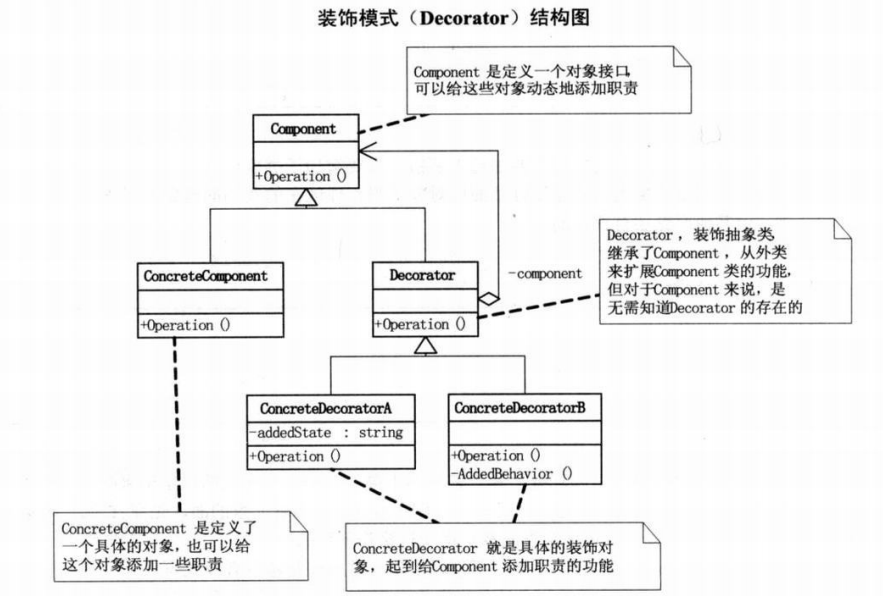装饰模式(Decorator):动态地给一个对象添加一些额外的职责,就增加功能来说,装饰模式(Decorator)比生成子类更为灵活。

Component:定义一个对象接口,可以给这些对象动态地添加职责;
ConcreteComponent:定义了一个具体的对象,可以给这个对象动态地添加一些职责;
Decorator:装饰抽象类,继承了Component,从外类来扩张Component类的功能,但对Component来说,是无需知道Decorator的存在的;
ConcreteDecoratorA和ConcreteDecoratorB:具体的装饰类,起到给Component对象添加职责的功能;
基本的代码实现:

 基本代码实现
基本代码实现
/// Component定义一个对象接口,可以给这些对象动态地添加职 责(功能之类的)
/// </summary>
abstract class Component
{
public abstract void Operation();
}
/// <summary>
/// 定义了一个具体的对象,可以给这个对象添加一项绝提的功能
/// </summary>
class ConcreteComponent:Component
{
public override void Operation()
{
Console.WriteLine("具体的操作对象");
}
}
abstract class Decorator:Component
{
/// <summary>
/// 被修饰对象
/// </summary>
protected Component component;
/// <summary>
/// 设置Component
/// </summary>
/// <param name="component"></param>
public void SetComponent(Component component)
{
this.component = component;
}
public override void Operation()
{
if (component != null)
{
component.Operation();
}
}
}
class ConcreteDecoratorA:Decorator
{
public ConcreteDecoratorA()
{
addState = "装饰1";
}
private string addState;
public override void Operation()
{
base.Operation();
Console.WriteLine(addState);
}
}
class ConcreteDecoratorB:Decorator
{
public override void Operation()
{
base.Operation();
Behiver();
}
private void Behiver()
{
Console.WriteLine("装饰B的特有功能");
}
}
class Program
{
static void Main(string[] args)
{
///装饰模式(Decorator)代码介绍,客户端(Client) ---Begin---
Component com = new ConcreteComponent();
ConcreteDecoratorA decA = new ConcreteDecoratorA();
ConcreteDecoratorB decB = new ConcreteDecoratorB();
decA.SetComponent(com);
decB.SetComponent(decA);
decB.Operation();
Console.ReadKey();
//装饰模式(Decorator)代码介绍,客户端(Client) ---End---
}
}
实例:模拟人的穿着:一个穿衣服的人 较某某某,戴帽子,穿西服,穿皮鞋

 代码
代码
/// 定义人这个抽象类
/// </summary>
abstract class Person
{
public abstract void Show();
}
/// <summary>
/// 这个人吧,有穿衣服的,有不穿的(原始),就继承人这个类后具体添加个穿衣服的特点
/// </summary>
class WareClothesPerson:Person
{
private string personName;
public WareClothesPerson(string PersonName)
{
this.personName = PersonName;
}
public override void Show()
{
if (string.IsNullOrEmpty(personName))
{
Console.WriteLine("此人竟然没有名字");
}
else
{
Console.WriteLine("大家好,我叫{0}", personName);
}
}
}
/// <summary>
/// 人穿的服饰抽象类
/// </summary>
abstract class Finery:Person
{
private Person person;
/// <summary>
/// 装载被修饰的人
/// </summary>
/// <param name="person">人的抽象类对象</param>
public void SetPerson(Person person)
{
this.person = person;
}
public override void Show()
{
if (person != null)
{
person.Show();
}
}
}
/// <summary>
/// 戴帽子
/// </summary>
class Hat:Finery
{
public override void Show()
{
base.Show();
Console.WriteLine("戴了个帽子");
}
}
/// <summary>
/// 穿皮鞋
/// </summary>
class LeatherShoes:Finery
{
public override void Show()
{
base.Show();
Console.WriteLine("穿了双皮鞋");
}
}
/// <summary>
/// 穿西服
/// </summary>
class Suit:Finery
{
public override void Show()
{
base.Show();
Console.WriteLine("穿了件西服");
}
}
class Program
{
static void Main(string[] args)
{
//装饰模式(Decorator)使用实例,客户端(Client) ---Begin---
Person ps = new WareClothesPerson("黑矿");
Hat hat = new Hat();
Suit suit = new Suit();
LeatherShoes leatherShoes = new LeatherShoes();
hat.SetPerson(ps);
suit.SetPerson(hat);
leatherShoes.SetPerson(suit);
leatherShoes.Show();
Console.ReadKey();
//装饰模式(Decorator)使用实例,客户端(Client) ---End---
}
}
思考变通:如果只有一个ConcreteComponent类而没有Component类,那么Decorator类可以是ConcreteComponent类的一个子类。同理,如果只有一个ConcreteDecorator类,那么就没有必要单独建立Decorator类,可以把Decorator类和ConcreteComponent类合并成一个类。
总结:
装饰模式(Decorator)主要功能:动态地为已有功能添加更多功能的一种方法;它把每一个要装饰的功能放在单独的类中,并让这个类包装它要装饰的对象,因此,当药执行特殊行为时,客户端代码可以根据需要有选择余地地、顺序地使用装饰功能包装对象。
好处:有效地把类的核心职责和装饰功能区分开,可以出去相关类中重复的装饰逻辑。




 本文详细介绍了装饰模式的概念及其应用,通过示例代码展示了如何为现有功能动态添加职责,并讨论了其优势及变通方法。
本文详细介绍了装饰模式的概念及其应用,通过示例代码展示了如何为现有功能动态添加职责,并讨论了其优势及变通方法。
















 625
625

 被折叠的 条评论
为什么被折叠?
被折叠的 条评论
为什么被折叠?








